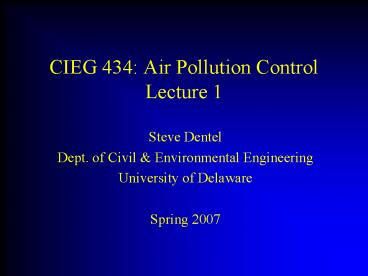CIEG 434: Air Pollution Control Lecture 1 - PowerPoint PPT Presentation
1 / 17
Title:
CIEG 434: Air Pollution Control Lecture 1
Description:
Part I Particulate contaminants and controls: Steve Dentel, ... colorless, tasteless, odorless, poisonous. from incomplete combustion of carbonaceous fuels ... – PowerPoint PPT presentation
Number of Views:380
Avg rating:3.0/5.0
Title: CIEG 434: Air Pollution Control Lecture 1
1
CIEG 434 Air Pollution ControlLecture 1
- Steve Dentel
- Dept. of Civil Environmental Engineering
- University of Delaware
- Spring 2007
2
Course Logistics
- INSTRUCTORS
- Part I Particulate contaminants and controls
Steve Dentel, 348 DuPont Hall, 831-8120,
dentel_at_udel.edu - Part II - Gaseous contaminants and controls Pei
Chiu, 344B DuPont Hall, 831-3104,
pei_at_ce.udel.edu.
3
- OFFICE HOURS
- Monday 1130 - 130. You can also make an
appointment with either instructor by phone or
email, or simply stop by. - TEXTBOOK
- Cooper, C. D. Alley, F. C., "Air Pollution
Control - A Design Approach", 3rd ed, Waveland
Press, 2002. - REFERENCES
- (1) De Nevers, N., "Air Pollution Control
Engineering", 2nd ed., McGraw-Hill, 2000.(2)
Heinsohn, R. J. and Kabel, R. L. "Sources and
Control of Air Pollution", Prentice Hall,
1998.(3) Crawford, M. "Air Pollution Control
Theory", McGraw-Hill, 1976.
4
ACTIVE PARTICIPATION
- Activities and extra efforts that contribute to
and demonstrate understanding of the subject
matter are encouraged and will be rewarded with
extra "active participation" points (up to 10
points/person/semester).
5
GRADING The total number of points is 250.
- If you earn a total of230 points or more, you
will receive an A or A-205 points or more, you
will receive a B, B, or B-180 points or more,
you will receive a C, C, or C-160 points or
more, you will receive a D, D, or D-You will
need a minimum of 160 points to pass.
6
Priority Air PollutantsSources, Properties, and
Effects
7
Definition of Air Pollution (DNREC)
- "The presence in the outdoor atmosphere of one or
more air contaminants in sufficient quantities
and of such characteristics and duration as to be
injurious to human, plant, or animal life or to
property or which unreasonably interferes with
the enjoyment of life and property within the
jurisdiction of the State."
8
Health concerns
9
NAAQS exist for 6 "criteria pollutants"
- PM10 and PM2.5
- CO
- Pb
- SO2
- NO2
- O3 (secondary)
- particulate matter
10
Carbon Monoxide (CO)
- colorless, tasteless, odorless, poisonous
- from incomplete combustion of carbonaceous fuels
- oxygen, temperature, mixing, residence time
- important pollutant in urban and indoor air
- 3/4 of CO emissions are related to
transportation - CO competes (gt200x) with O2 to bind hemoglobin
11
Lead (Pb)
- Before 1984, major Pb source was Pb(C2H5)4, an
antiknock agent in gasoline invented by T.
Midgley - 1970 CAAA required 90 cut in CO, NOx, VOC
- Auto industry chose to use catalytic converters
- Catalytic converters were poisoned by Pb
- In 1984, EPA lowered allowable Pb in gasoline
- Now most Pb comes from point (industrial) sources
12
Lead (Pb)
- industrial sources smelters, lead acid
batteries, etc. - other sources Pb3(CO3)2(OH)2 and Pb3O4 in
paint, soil around highways, etc. - most exposure through inhalation of Pb particles
(also through drinking water due to Pb solder) - esp. detrimental to children and pregnant women
13
NOx (NO NO2)
- NO colorless, non-toxic, oxidizes to NO2
- NO2 red-brown, lung irritant, bronchitis,
pneumonia - Sources 50 industrial, 50 mobile
- Mechanisms fuel NOx thermal NOx (1000 K)
- NOx VOCs h? gt photochemical smog
- NOx OH. gt HNO3 (acid precipitation)
- Eutrophication
14
SOx (SO2 SO3)
- approx. 20 MT/yr, 90 from fossil fuel burning,
of which 85 comes from power plants (75 of
total) - other sources oil refining, copper smelting,
autos - coal gt oil (less than 1 ppm after refining) gt
gas - both highly soluble, absorbed after inhalation
- SOx OH./O2 gt SO3 gt H2SO4 (acid rain)
- SO4 also forms 2o PM2.5 may reach deep into
lungs
15
O3 VOC (smog)
- NOx VOCs h? gt photochemical smog (O3,
formaldehyde, peroxyacetyl nitrate, other
oxidants) - urban O3 peaks at 11 am, after NO NO2
- cough, headache, eye/throat irritation, lung
damage (susceptible sub-populations e.g., people
w/ asthma) - believed to be responsible for most of the
damage to agriculture due to air pollution
16
Particulate Matter (PM)
- Tiny solid or liquid particles suspended in air
- gt10 mm easily captured by nose upper tracks
- lt0.1 mm captured, exhaled, or coagulate to gt0.1
mm - 0.1-10 (esp. 2-4) mm penetrate deposit in
lungs - May contain metals, PAHs, pesticides, other
toxics - visibility reduction by 0.3-0.7 mm particles
- damage to infrastructure by acid mist/fog
17
CO2
- Not included in NAAQS
- Was approximately 0.03 of atmospheric air (300
ppm). Now approaching 400 ppm. - Sources respiration, combustion, dissolved
carbonates in surface waters, etc. - Now unequivocally linked to global warming
18
Next































